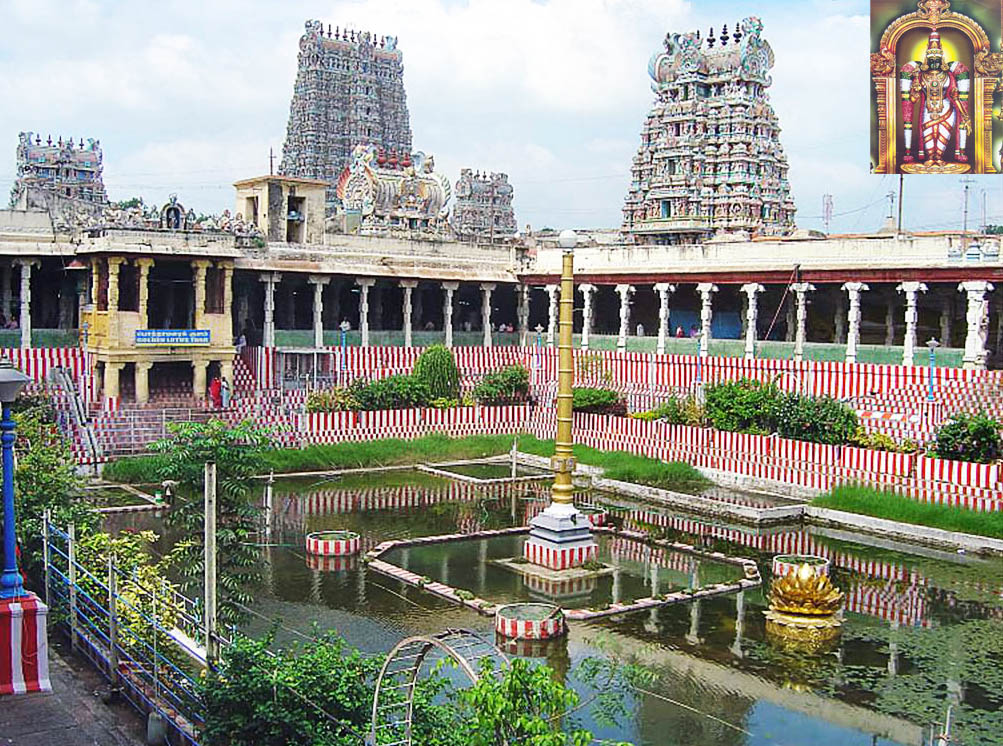|
|
Minakshi Temple

Name of the Temple |
|
Location |
|
| How to reach there? |
- By Air: Madhurai International airport is 10 km north from Mīnākṣhi temple.
- By Train : East Madhurai railway station is 3 km away from Mīnākṣhi temple.
- By Road: Madhurai is connected to the rest of the state through the National Highway 7 from Kanyakumari to Varanasi, 38 from Thirucchi to Madhurai and 85 from Kochi to Thonḍi Point.
|
Rulers/builders and Time Period
|
- Pāndya King Kulaśhekhara
- The temple forms the heart and lifeline of the 2500 year old city of Madhurai.
|
Deity/Deities |
|
Architecture Style
|
- There are 985 beautifully sculptured pillars supporting the temple and forming the thousand pillar manḍapam hall.
- The sanctums of Sundhareśhvara and Mīnākshi are surrounded by a number of smaller shrines and grand pillared halls.
- Ashta Śakthi Manḍapam: This Manḍapam is an impressive structure, with a hemispherical ceiling. It is 14m long and 5.5m wide. There are bas-reliefs all over the place. Over the entrance one of them depicts the marriage of Goddess Mīnākshi with Lord Somasundhara. The Manḍapam derives its name, the "Ashta Sakthi", from the fact it contains sculptures of the eight Śhakthis.
- Those of the four principal Nāyanmārs were added during renovation of the temple in 1960-63. Most impressive are the 12 gopuras of the temple whose soaring towers are made of solid granite bases and have paintings of different deities, mythical animals and monsters.
- The gopuras are pyramidal gates rising to heights exceeding 50 metres. The ūnjal and kilikatti manḍapams - A Gopura of three tiers stands over the entrance from this Manḍapam into the shrine of the Goddess. Built in 1227 by Vambathura Ānandha Thāndava Nambi, it is named the Vambathura Gopuram after him.
- The shrine consists of a square sanctum, an Ardhhamanḍapam and a Mukhhamanḍapam. In the niches on the walls of the shrine are images of Icchāśhakthi in the south, Kriyāśhakthi in the west, and Gnyānaśhakthi in the north.
- There are shrines of Vināyaka and Subrahmanya in the outer prakāra. They probably belong to the fifteenth century.
|
Special Reference to Fine Arts |
- There are a number of historic shrines in the Prakāras.
- Opposite to an entrance into the first from the Mahāmanḍapam there is one of Lord Sabhāpathi. This is the famous Velli ambalam where one of the Lord's divine sports took place when, at the request of the sages, Pathanjali and Vyāgrapādha, He danced as Lord Natarāja.
- In the second Prakāra a shrine, now called that of the Sangam poets, contains images of many of them. In the same Prakāra there is a shrine apparently dedicated to Kariyamānikka Perumāl, but now empty. Also in the same Prakāra there is a row of fourteen small shrines, called the "īśhvarams". Many of them contain Lingas.
|
Other Special Features
|
- Mudhali Pillai Manḍapam: The Mudhali Pillai Manḍapam follows the Chithra Gopura. Added in 1613, it is 183m long and 7.6m wide. On its wall are many purānic scenes. It used to be without any natural light, but windows were added in the last renovation.
|
Special Reference to Performing Arts:
|
- Paranjothi Munivar wrote the Tiruviḷaiyāḍal Purāṇam in the sixteenth century. It is regarded as the temple's Sthhalapurāṇa. An earlier work adds a few celestial sports not included in the latter. These are, or rather were painted on the walls around the Golden Lily Tank. Some of the painted wooden panels are in the Temple Museum.
- The earliest references available to any structure in this temple is a hymn of Sambhandar's, in the seventh century, which refers to the "Kapāli Madhil". The present inner walls of the Lords shrine bear this name today. In the early times the entire temple must have been confined to the area between these walls, and the structures must have been of brick and mortar.
- Down the centuries, the temple has been centre of academy of learning of Tamil culture, literature, art, music and dance. All three assemblies of Tamil language, the Tamil Sangam (about the 3rd century BCE to the 3rd century CE), were held at Madhurai. Great Tamil poets of different epochs participated in these assemblies and their composition is called Sangam literature During the third Tamil sangam, the comparative merits of the poets was decided by letting the works float in the lotus tank of the temple. It was believed that a divine force would cause the work of superior merit to float on the surface while the inferior literary work would sink.
- Thevāram , the 7th-8th century Tamil compositions on Śhiva are works by the three prominent Nāyanārs ( Śhaivites ) namely Appar, Sundharar and Thirugnyānasambandhar The temple has been glorified by the hymns of Thevāram by all the three poets. Different hymns of Sambandhar on the temple mention the queen of Pāndya Nāḍu , his desire to defeat Jains in debate, the miracle of him curing the king's fever, the Jains' provocation of Sambandhar by burning his house and challenging him to debate, and Sambandhar's eventual victory over them.
- There are few poets in Tamil history who sang about goddess Pārvathi, the notable among them is Kumaraguruparar , a 17th century Tamil poet who composed Mīnākshi Pillaitamizh on Mīnākshi of this temple. In pillaitamizh (a genre of Tamil literature) history, the king Thirumalai Nāyak's most crucial act of patronage was his link with Kumaraguruparar. Kumaraguruparar visited lot of temples and when he visited this temple, he composed pillaitamizh on Mīnākshi. Legend has it that goddess appeared in the dreams of Nāyak directing him to arrange the recital of Kumaraguruparar before learned assembly. The king made elobrate arrangements for the event. Goddess was enjoying the recital and she impersonated in the form of a small girl. As Kumaraguruparar was explaining the 61st verse, the goddess appreciated by garlanding the poet with a string of pearls and disappeared.
- “Māmava Mīnākshi” is a popular krithi by Muthuswāmi Dīkshithar in the Rāga Varāli on the Goddess Mīnākshi. (Others listed down)
|
Bibliography |
|
|
Gr��ere Kartenansicht 



|
|















